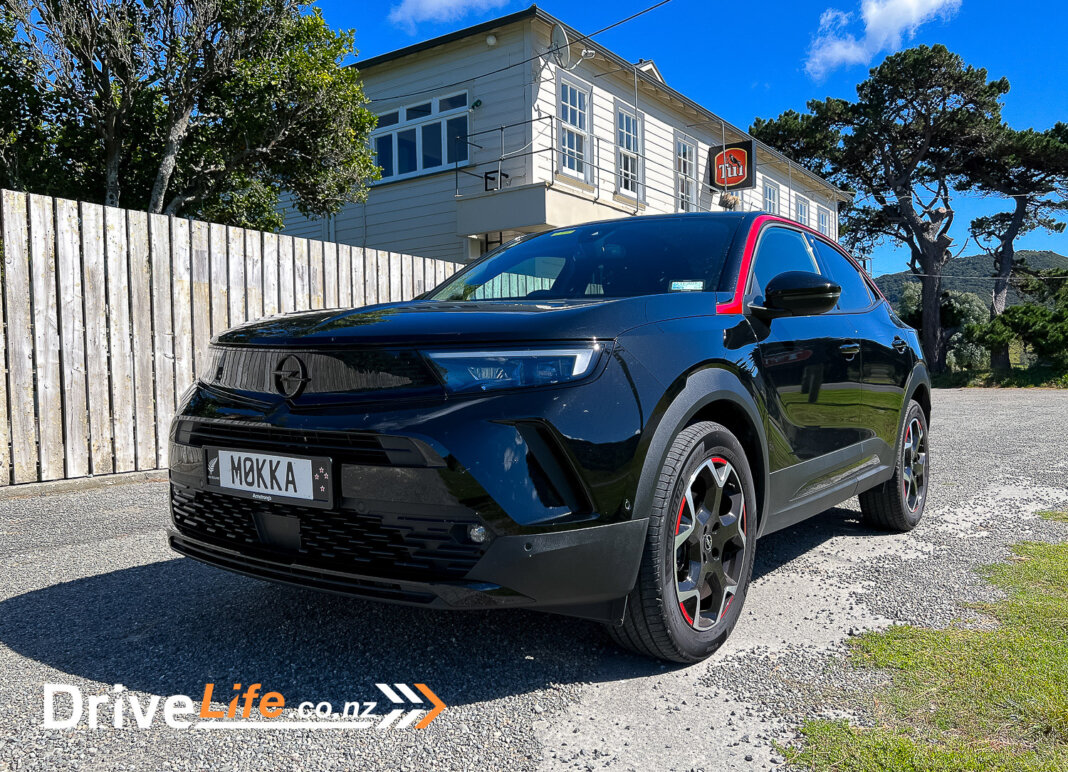Being represented in New Zealand by only four models, we have had half the family of Opel’s offerings through the Drivelife offices recently.
Having already done the small 5-door hatch that is the Opel Corsa SRi , and the full-electric SUV that is the Opel Mokka-e , it was now time to try out the latter’s petrol sister, the Opel Mokka SRi.
I spent a week around the city and open roads of the lower half of the North Island, clocking up almost 900km, and at the end was surprised with my thoughts on it.
Having driven German cars for the last 20 years, I was looking forward to trying out the Opel Mokka, however, it was quickly apparent that this was German in name only, having a much more French personality. Car enthusiasts will not be surprised by this as it has very much been General Motors over the years, and recently fallen under the PSA / Stellantis group.
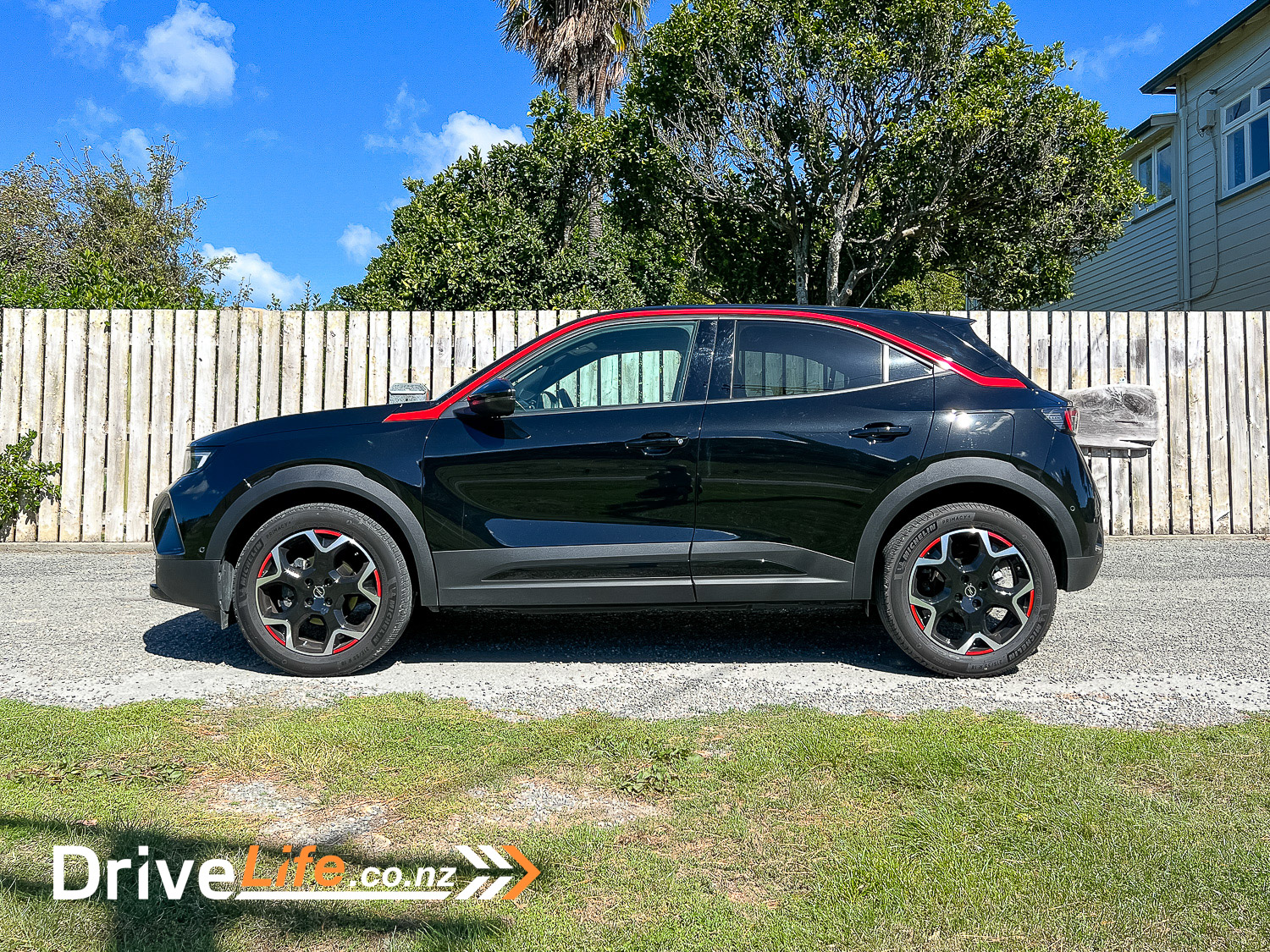
What We Like and Dislike About The 2023 Opel Mokka SRi
What we like
- Impressive Engine
- Crisp instrument cluster
- Comfortable steering wheel
- Design hits the target market
What we don’t like
- Cheap seats
- Limited visibility
- Unintuitive Controls
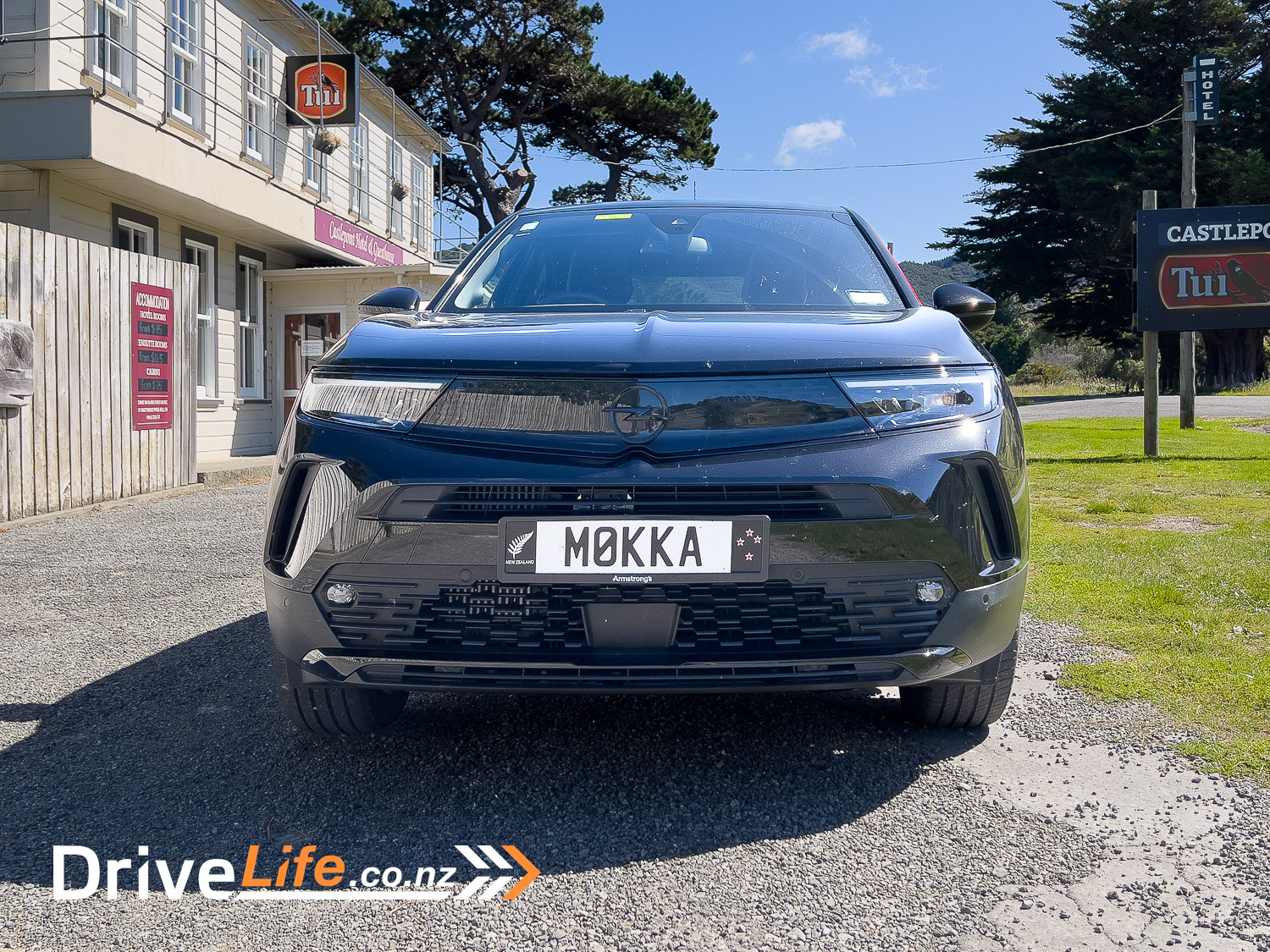
What’s In The 2023 Opel Mokka Range?
If you want the petrol form, then the 2023 Opel Mokka comes in two versions. The base model “Edition” and the higher specification “SRi”.
Both versions feature the same 1.2-litre 3-cylinder engine, 8-speed automatic gearbox and are front-wheel drive.
For this review, we are testing the SRi model.
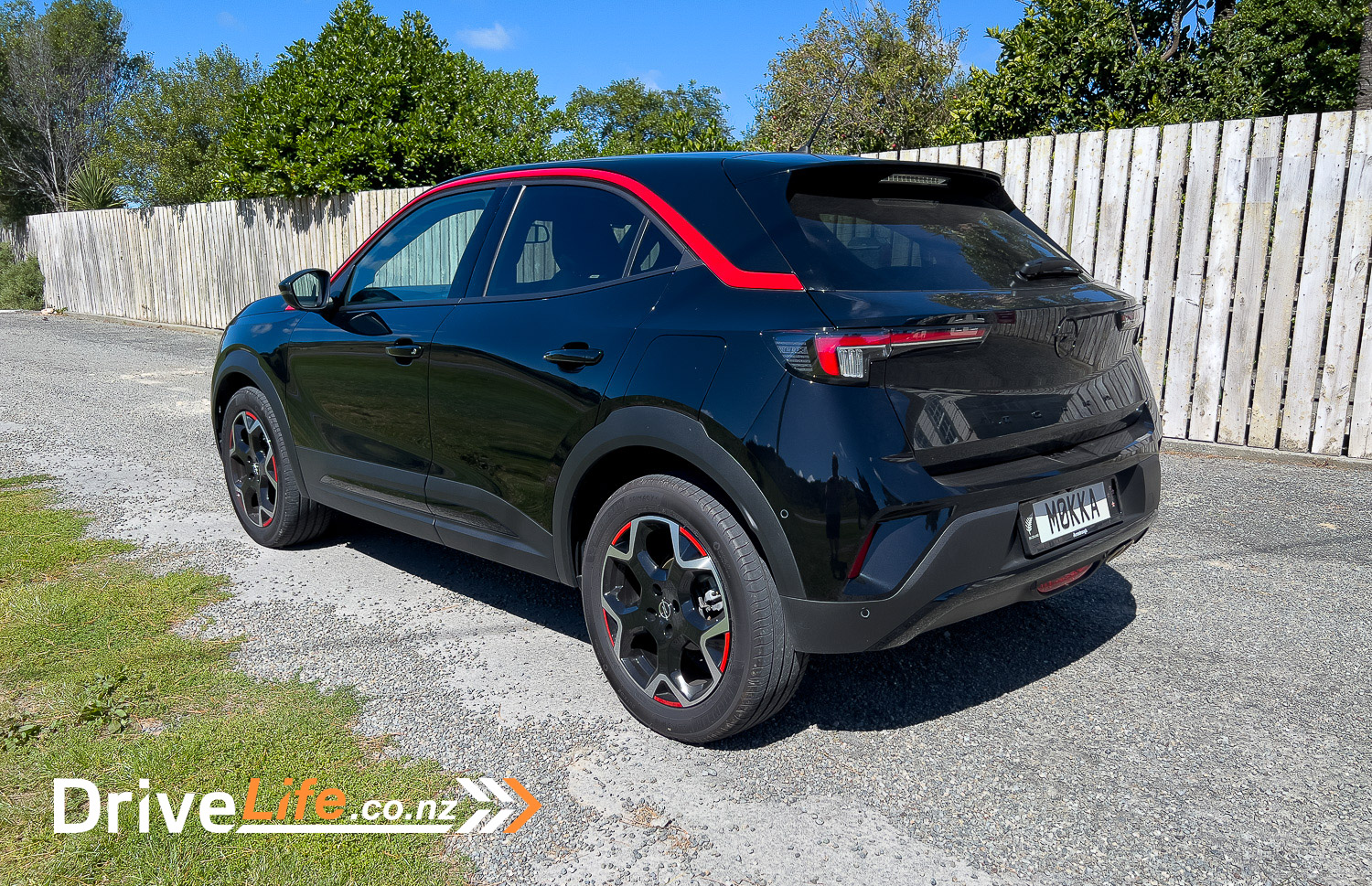
2023 Opel Mokka Standard Equipment Highlights
The standard “Edition” will get you:
- Eco-LED headlights with high beam assist
- Active Safety Brake
- Blind Spot Monitoring
- Active Lane Departure Warning
- 17” diamond cut alloy wheels
- Front & rear parking sensors with reversing camera
- 7” digital instrument cluster
- 7” central touchscreen with smartphone connectivity
- Heated steering wheel and front seats
- Esp and hill start assist
- Electronic immobiliser
Moving up to the “SRi” you additionally get:
- IntelliLux LED® Matrix headlights
- Black roof & bonnet
- Black exterior trims with red upper window moulding
- 18” diamond-cut alloy wheels
- Adaptive cruise control with Stop&Go
- Advanced Active Safety Brake
- Lane Positioning Assist (semi-autonomous)
- 12” digital instrument cluster
- 10” central touchscreen with Navigation & smartphone connectivity
Our Review Vehicle’s Optional Equipment
Diamond Black Metallic Paint added $550 to the price.
Including the optional equipment, our review car’s retail price is $45,540.
Browsing through the Opel website, you are limited to just one option, that being the paint colour. The standard is Matcha Green and all other options come as a $500 upgrade:
- Voltaic Blue
- Quartz Grey
- Jade White
- Power Red
- Diamond Black
For a full list of specs and options available for the Opel Mokka SRi jump on over to the Opel New Zealand website
How Does The 2023 Opel Mokka SRi Compare To Its Competition?
All prices below exclude the refund or additional cost of the New Zealand Clean Car Programme.
| Make/ Model | Engine | Power/ Torque kW/Nm | Seats | Fuel L/100km | Towing Capacity, Kg | Boot Space, litres | Price (excl CCP) |
| Hyundai Tucson MPI | 2.0-litre, 4-cylinder petrol | 115 / 192 | 5 | 9.6 | 750 | 620 | $46,990 |
| Nissan Juke Ti | 1.0-litre, 3-cylinder turbo petrol | 84 / 180 | 5 | 5.8 | 648 | $45,990 | |
| Opel /Mokka SRi | 1.2-litre, 3-cylinder turbo petrol | 96 / 230 | 5 | 7.2 | 640 | 350 | $43,990 |
| Volkswagen / T-Roc TSI Life | 1.4-litre, 4-cylinder turbo petrol | 110 / 250 | 5 | 7.0 | 670 | 445 | $43,490 |
| Mazda / CX-30 GSX | 2.0-litre, 4-cylinder petrol | 114 / 200 | 5 | 7.2 | 600 | 430 | $43,190 |
| Kia Sportage LX PLus Urban | 2.0-litre, 4-cylinder petrol | 115 / 192 | 5 | 9.0 | 750 | 543 | $42,290 |
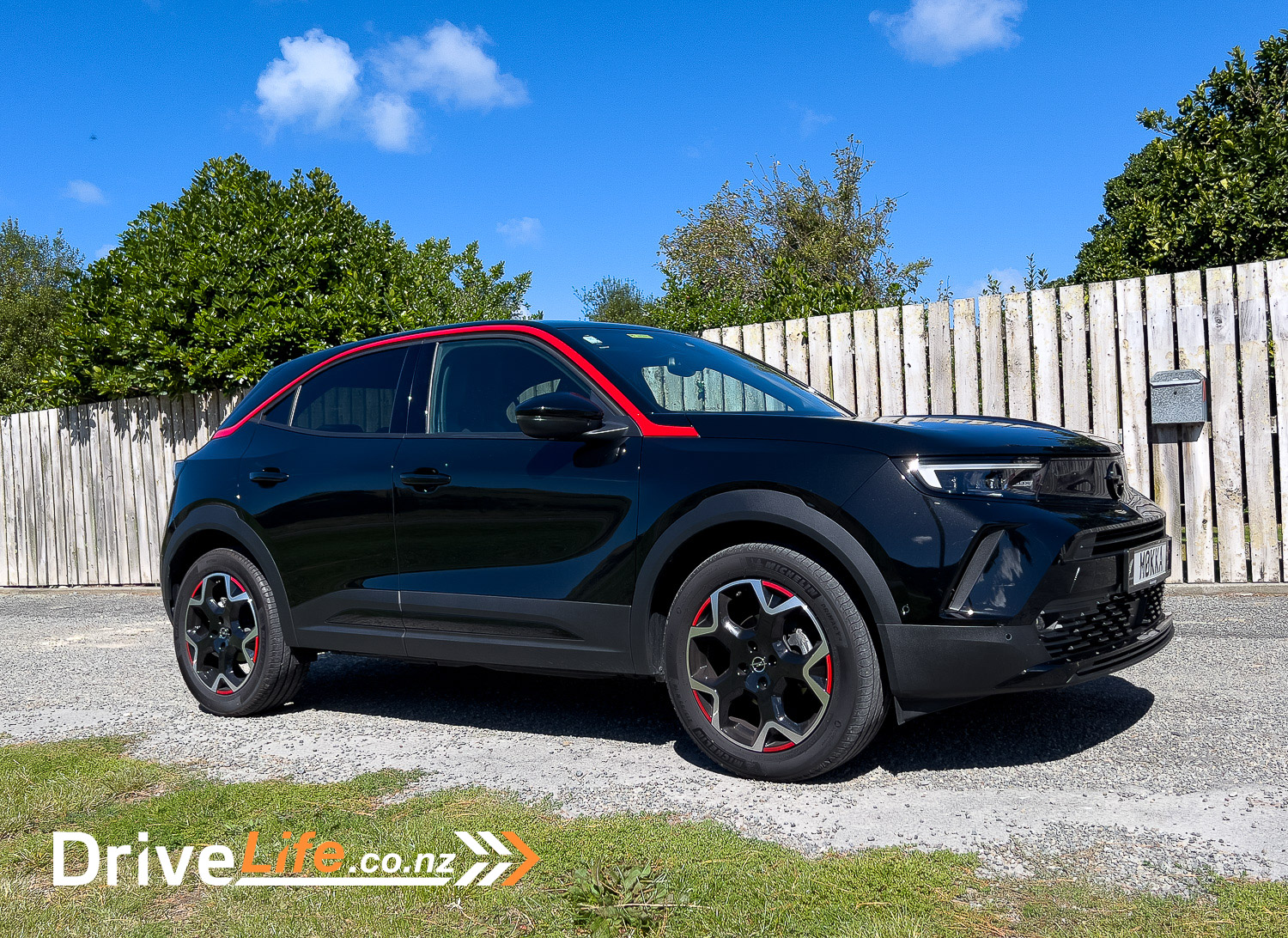
First Impressions Of The 2023 Opel Mokka SRi
Our test model was finished in Diamond Black, with the ubiquitous red roof stripes. It presents a striking visual impression and upon picking up the vehicle it is obvious this unique appearance and personality will quickly divide opinions. You will either fall in love or see it as just another small SUV.
While the design is well thought-out and there is nothing that looks wrong, it is clearly aimed at the younger market, of which I am not a member, and I suspect that it will be a head turner and get a lot of praise from this demographic.
Personally, it did not do much for me, appearing quite bulky for what is a small to medium SUV and not really hitting the spot that would make me want to stop and look further. I know Fred liked the looks of the Mokka-e SRi version in his review, and looking at his photos I think color is probably very important for this shape. The two-tone white and black which he had does look very striking and shows off the form and plane changes much nicer.
The black-on-black of this example hides a lot of the visual flare, I see this as a personal preference and it will definitely have appeal for the younger demographic.
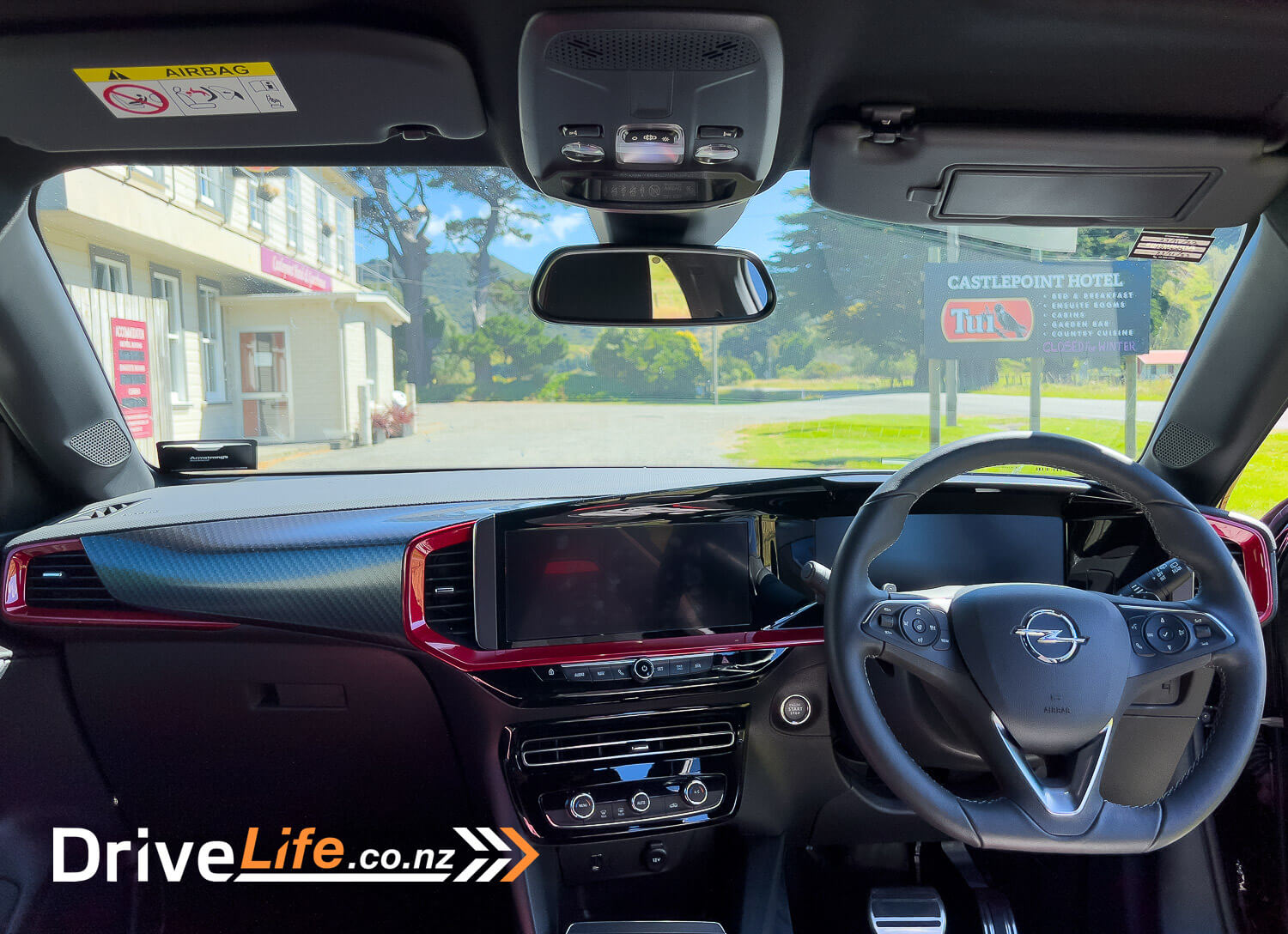
What’s The Interior Like In The 2023 Opel Mokka SRi?
Opening the door to climb inside, the interior looks pretty nice and inviting. My first attempt however at getting inside was rather awkward. The Mokka features a high, lower sill on the doors and a low seat, which resulted in me finding myself kind of falling into it. Maybe it is trying for the sporty feel? My wife who was often traveling with me also commented the same and we never really adapted to this over the week.
Once seated, you find yourself looking at a very nice instrument panel, probably the highlight of the interior for me. It is extremely crisp and the display modes available were very clean and easy to read, ranging from simplistic to more specific information panels. The screen is very uncluttered and once you have worked out the controls, navigating between them is pretty straightforward.
In front of the screen is a nice steering wheel. It has a decent sectional diameter, was good quality material and ergonomically was very comfortable to hold whilst driving. The various thumb controls were easy to get hold of, but I did find the indicator stalks a little high for my liking.
To the left of the driver area is a reasonably sized 10” touchscreen, which has various displays for the radio, car settings/information, SatNav and communications. Again, it is super crisp and clear. The Mokka still features a high proportion of old-school manual controls in the cockpit, and below the digital panel is a row of buttons to change the display, a manual rotary dial for volume and a big on/off button.
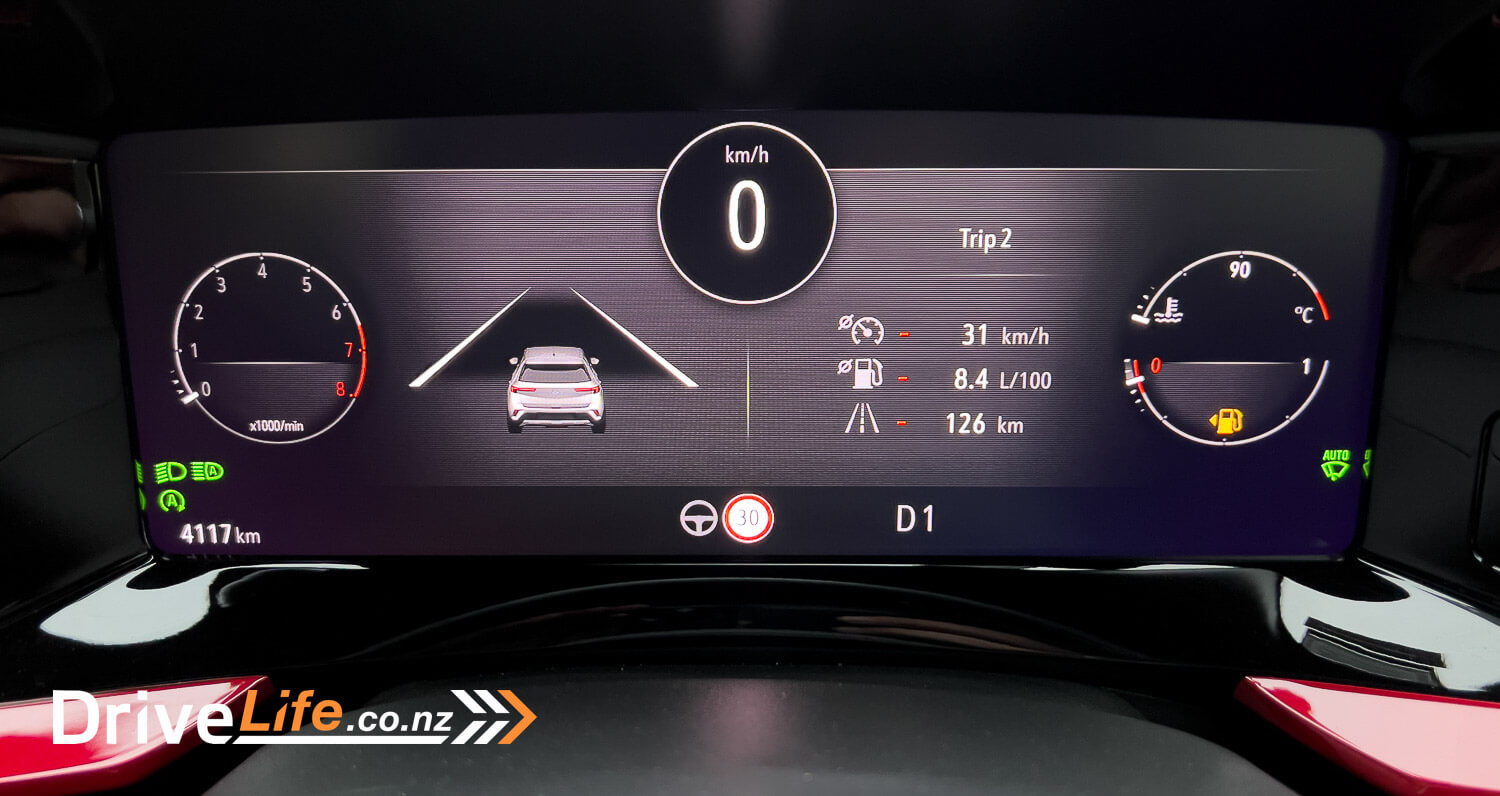
Again moving down from this you will find a very manual and familiar set of AC controls. Airflow in the front was quite good and I actually appreciated that unlike a lot of cars the vents didn’t appear to be set to blast air straight at my face and hands.
The centre console is fairly standard, with a drive selector, parking brake and various drive function on/off switches and a reasonably large-looking storage space. It does however go down to a smaller area at the bottom which I felt reduced its functionality and the diameter was too small for my drink bottle. There is also a 12-volt socket and USB-A port for your charging requirements.
The passenger has a large-looking glove box, but again once you open it the usable size is actually pretty small, with only half it being of any use.
The overall aesthetic of the front continues the design language and is also aimed at the younger generation with highly polished black plastic dominating the centre console and instrument panel, bright red trim bordering it and a faux carbon dash. Again not my thing, but I can see how it would be very appealing to the target audience.
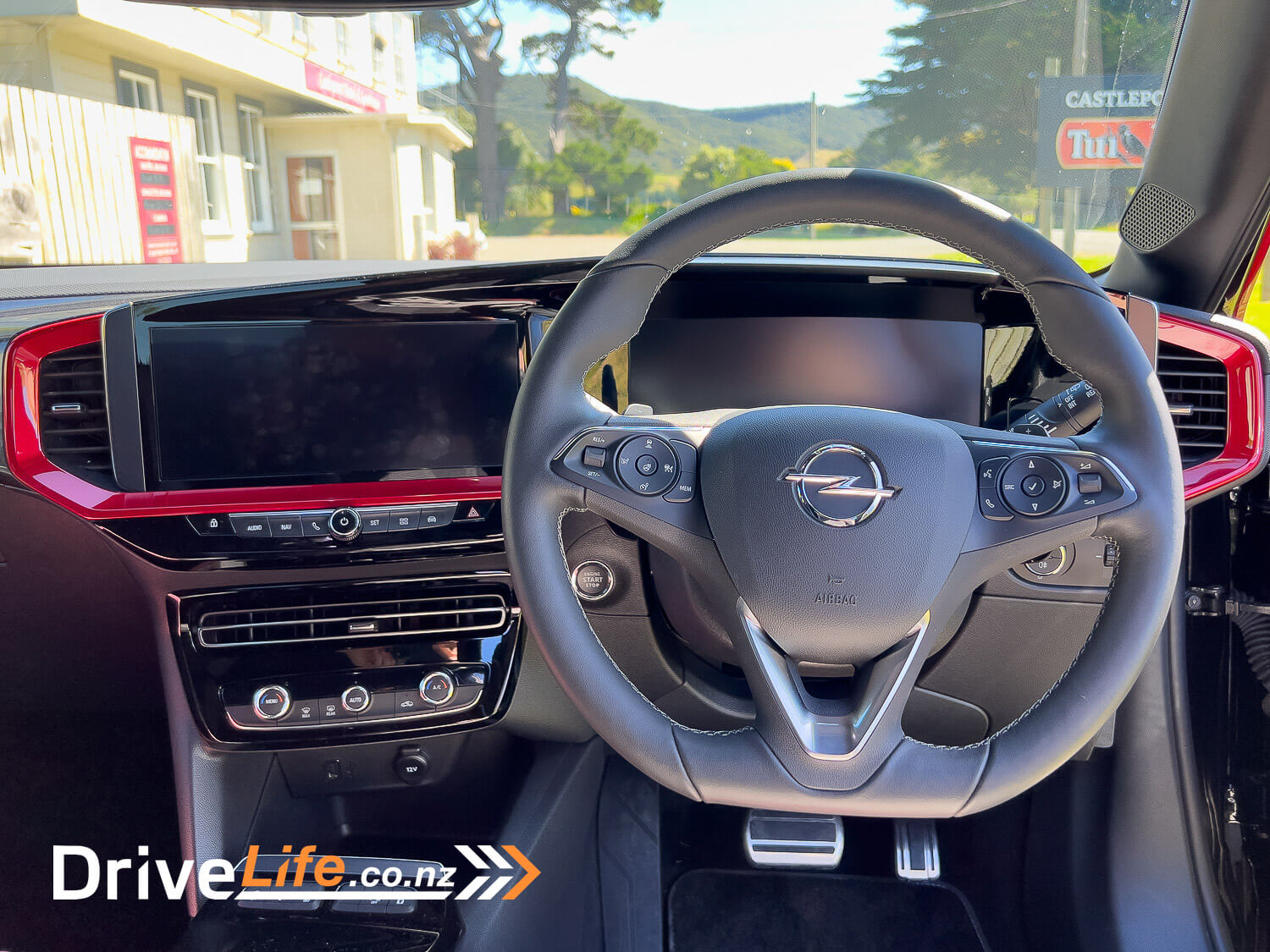
The general finish is very good and all materials look well made and fitted. Door panels have a nice leatherish finish and feel solid. Perhaps the seats are a little let down as they don’t feature any electronic controls. This was surprising I thought and would hope it was standard in a $45k car.
The rear passenger area was ok. I’m average height and with the driver and passenger seats in their normal position, there was enough room in the rear for two adults. Headroom was fine but I wouldn’t want to be any taller. One thing that did stick out was the lack of grab handles in both the front and rear. A strange omission I thought. The rear of the centre console features two USB-A ports handy for the kids, and a set of effective vents.
Moving towards the boot, on paper it is on the small side at 310 litres. However, for a couple it was plenty roomy for our requirements on a weekend away and we managed to fill it up with all we needed without overflowing into the rear seats. While there are no electronics to open and shut the boot, it does have a very convenient recess in the trim that helps to close it, necessary as the boot does open quite high. Under the false floor there was no spare tire, but instead an inflation kit and jack.
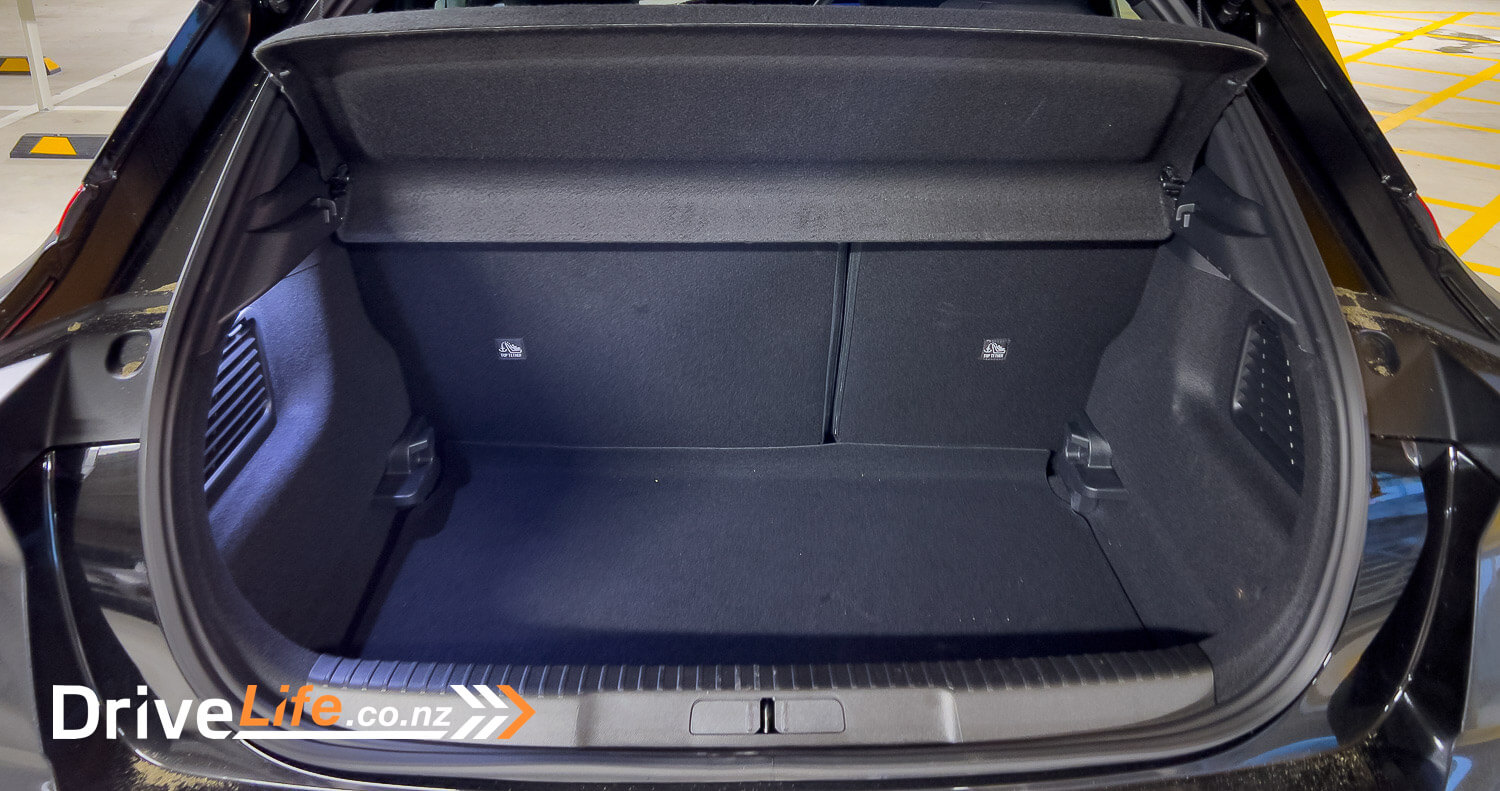
What’s The 2023 Opel Mokka SRi Like To Drive?
After my initial clumsy entrance into the car, it was time to set off from the dealer and into town. It’s now that I start to think about the driving experience and the first impression I had was that the car feels very big on the outside but small on the interior. Possibly this is due to the enormous bonnet that is always in your field of view. It is physically not a big vehicle, so this was a strange feeling. From my seating position, forward visibility was very limited. The roofline is very low, giving a small viewport and this was even more constricted by a large and low centre rear-view mirror.
This and the A-pillars were constantly in my field of view. I’m picky when it comes to driving position, and over the entire week I had the vehicle I never really got used to this nor could I find a position that worked well for me. Ergonomically the relationship between the steering wheel and seat was great, but that between the seat and pedals did suffer from the French offset pedal symptom and a weird thing where the default resting position of the brake pedal is significantly closer to you than the accelerator. For me, this is really annoying as you can’t easily slide your foot across from one to the other.
The next step was to connect my phone, this should be easy, I thought. Getting to the connection screen was straightforward, but there was no obvious way to “add” a new phone. Eventually, I worked it out, and once connected it worked very simply and as expected. One quirk that became apparent every time I drove the car however was that the default setting for the media centre every time you turned the car on was the radio.
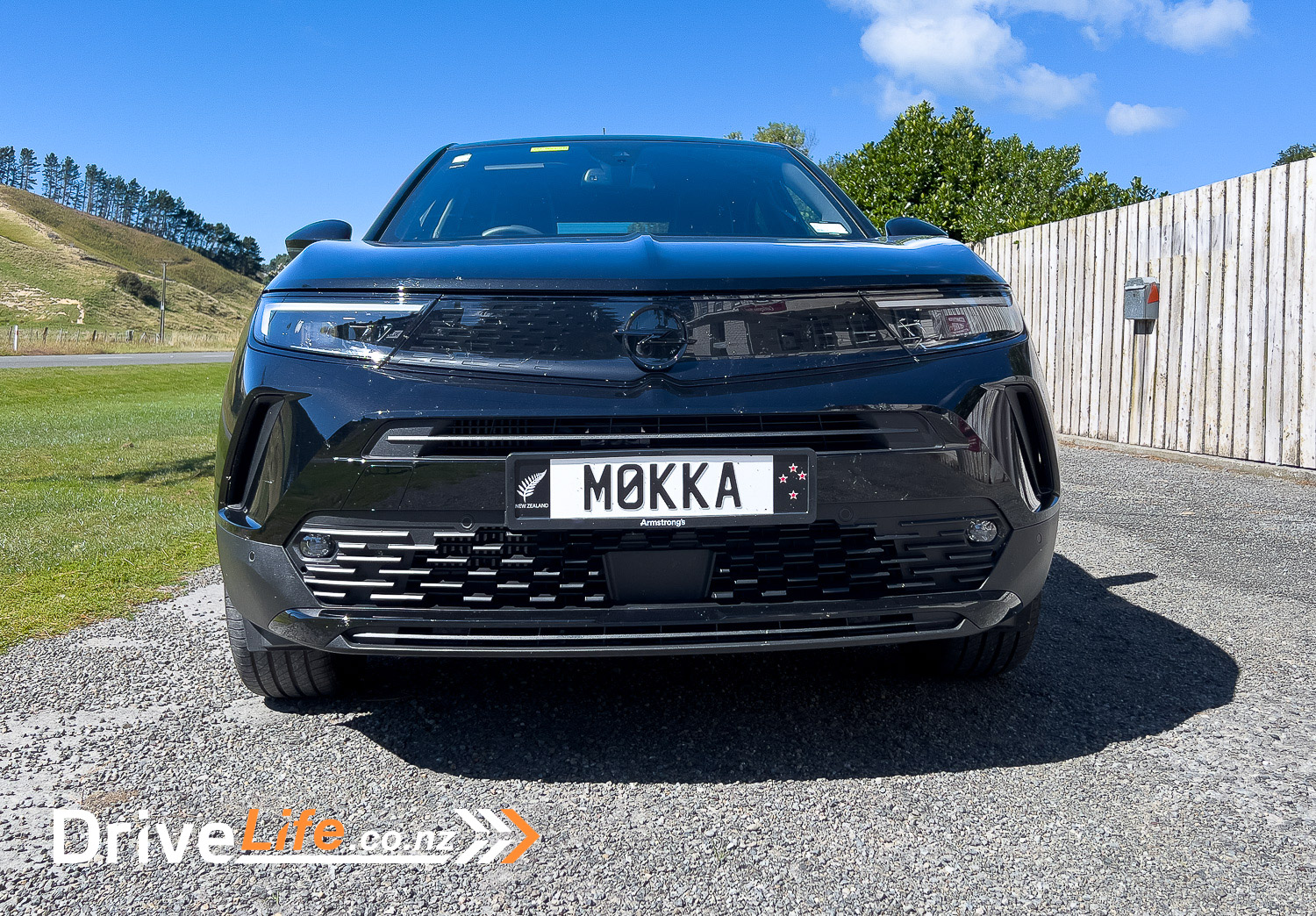
Starting the car was straightforward, a nice big button does the job and the proximity sensor key makes it easy. The centre console features the electronic hand brake, easy to turn off, but putting in Park at the end of a trip takes getting used to as the Park button to the right is very small. The drive selector is a chunky leaver but for some reason again I found it not intuitive going from Park to Drive. Maybe it is me, but I was starting to notice a theme in that the Mokka controls and I were not really in sync.
Once this was sorted, it was off into town. Driving through town in Normal mode was pleasant. It still had that visual feeling of a big car, but dynamically there was none of this. The Mokka was surprisingly quiet, the engine nice and responsive, the steering had a good weight and feel to it and there were no real dramas. It was a nice experience and just what I would expect for a car of this value. The heated steering wheel was a nice touch and while not really a necessity for New Zealand I used it once and thought if it’s there, why not.
The next few days spent driving around town was a fairly non-eventful experience. Over time the quirks of the Mokka became less noticeable, with the exception of the entry/exit issues.
Living in Wellington you get to experience all weather conditions each week, so this gave me the opportunity to fully try the systems. The wipers did a great job of clearing the screen but noticeably when in Auto mode were very slow to reduce their speed and halt when the rain stopped. Despite being simple, the AC worked well and we never had any issues with misting or fogging of the screens, and the cabin was cooled and heated very efficiently. At night time I noticed the headlights were really good, providing nice clear vision for a good distance.
For the upcoming weekend, my wife and I were planning a weekend away and we eagerly looked forward to trying the Mokka out on a longer trip.
On an approximately 300km trip, I really noticed a difference in the car. Driving around town, nothing really stood out, it just did what a car should. On the open road however it became apparent that the Mokka’s strength is as a city vehicle and not so much on the motorways or back roads of New Zealand. After 300km I found driving the Mokka for a long time on the open road a tiring experience.
At motorway speed in New Zealand the steering changes a lot. Gone is the nice, weighted feeling from town and instead it gets a lot lighter, too much so for my liking. Normally I would expect the opposite, nice light steering around town, getting heavier and more reassuring when you are at speed.
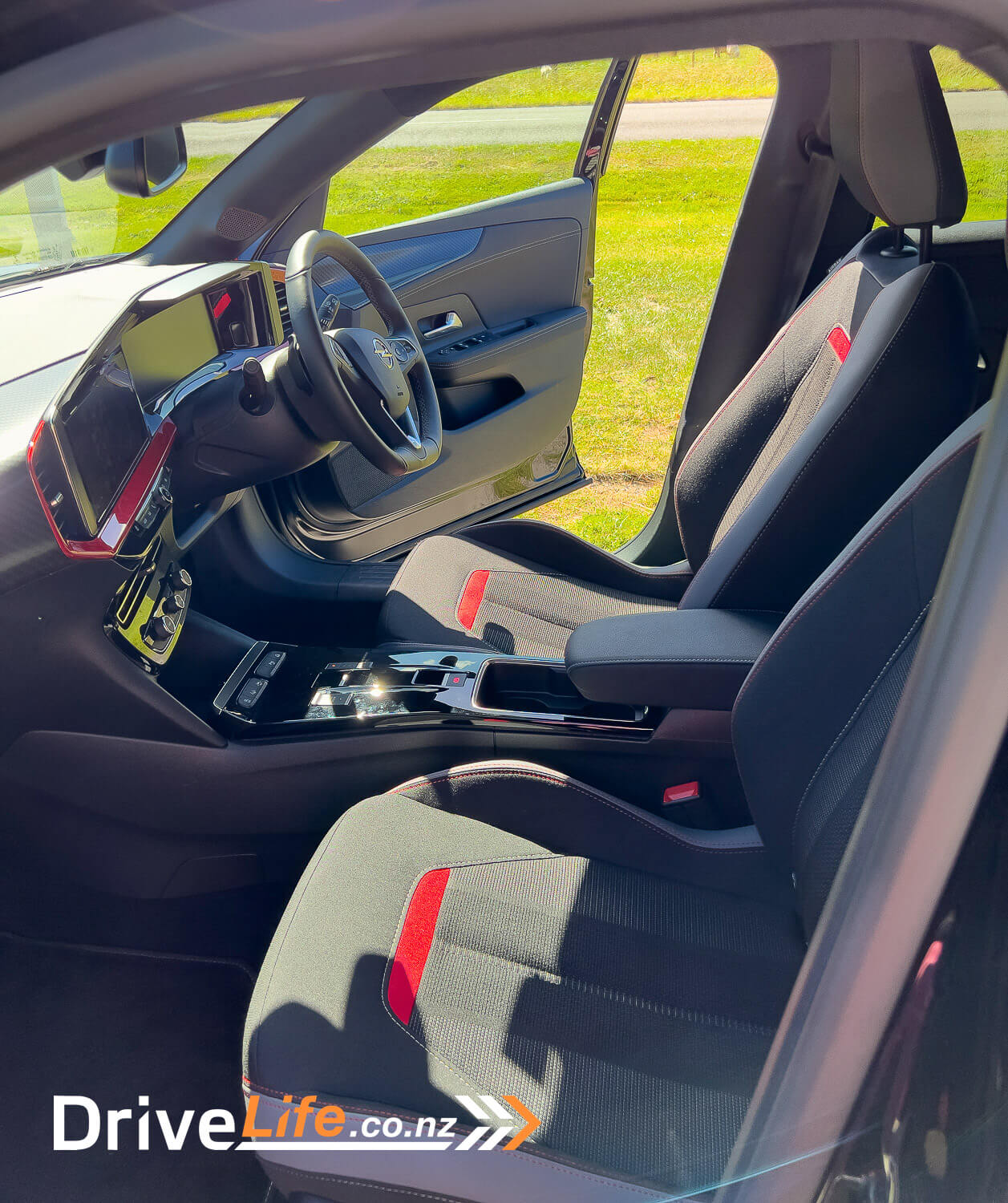
On nice, sealed motorway road noise was good, and wind noise was almost non-existent. The only noise apparent (motor withstanding) was a minor rattle in the left-hand passenger door that worsened over time. I’m sure it will be an easy fix at the vehicle’s first service so no real worry.
Once we left State Highway 1 and got onto the chipseal that makes up the majority of New Zealand’s motorways, tyre noise was night and day different. The Michelin Primacy 4’s were roaring away and gone was the near silence experienced whilst cruising around town. Also noticeable was the ride quality, while the Mokka handled the bumps and potholes fine and anything in the vertical body control, body roll and a feeling of the vehicle falling over was extremely noticeable, particularly in the rear whilst navigating twisting corners on the open roads at moderate speed.
To top this off, the seats are probably the most disappointing thing in the interior. They are extremely economically made with little structural support in the base and feel like just a foam squab sitting on a flat base. There is a definite feeling of your backside not being supported during corners. Lumbar support is better, but for an interior that is generally very well made these were a letdown. I can’t help but think a higher-spec seat would really help.
A couple of hours in, we stopped for the customary fish and chips, and I thought I’d take some photos. Ten minutes later and I still hadn’t worked out how to open the bonnet for the obligatory engine photo. A quick scan of the manual and I was none the wiser, as it clearly showed the leaver in the right-hand driver’s footwell, exactly where I would expect to find it. Except it’s not, it’s actually in the passenger footwell. I understand this from a manufacturing point of view, but it did seem like a massive oversight in whoever proofread the owner’s manual.
Positives from the drive included a pretty good sound system with nice volume and clear sound, and Apple CarPlay integration that worked well. A couple of phone calls worked seamlessly and those on the other end never mentioned the sound was echoey or I was in a small room, which often is the case. Cruise control was used a bit and worked well though it took time getting used to setting up. I played a lot with the automatic vehicle following distance, and this worked really well. It would keep you the correct distance and only really got caught out once we got into twisty sections of road. The automatic lane assist seemed to have a mind of its own however. Sometimes it was great, vibrating the steering wheel and directing you back into your lane when necessary. Other times it did nothing and I could never work out what the triggers were.
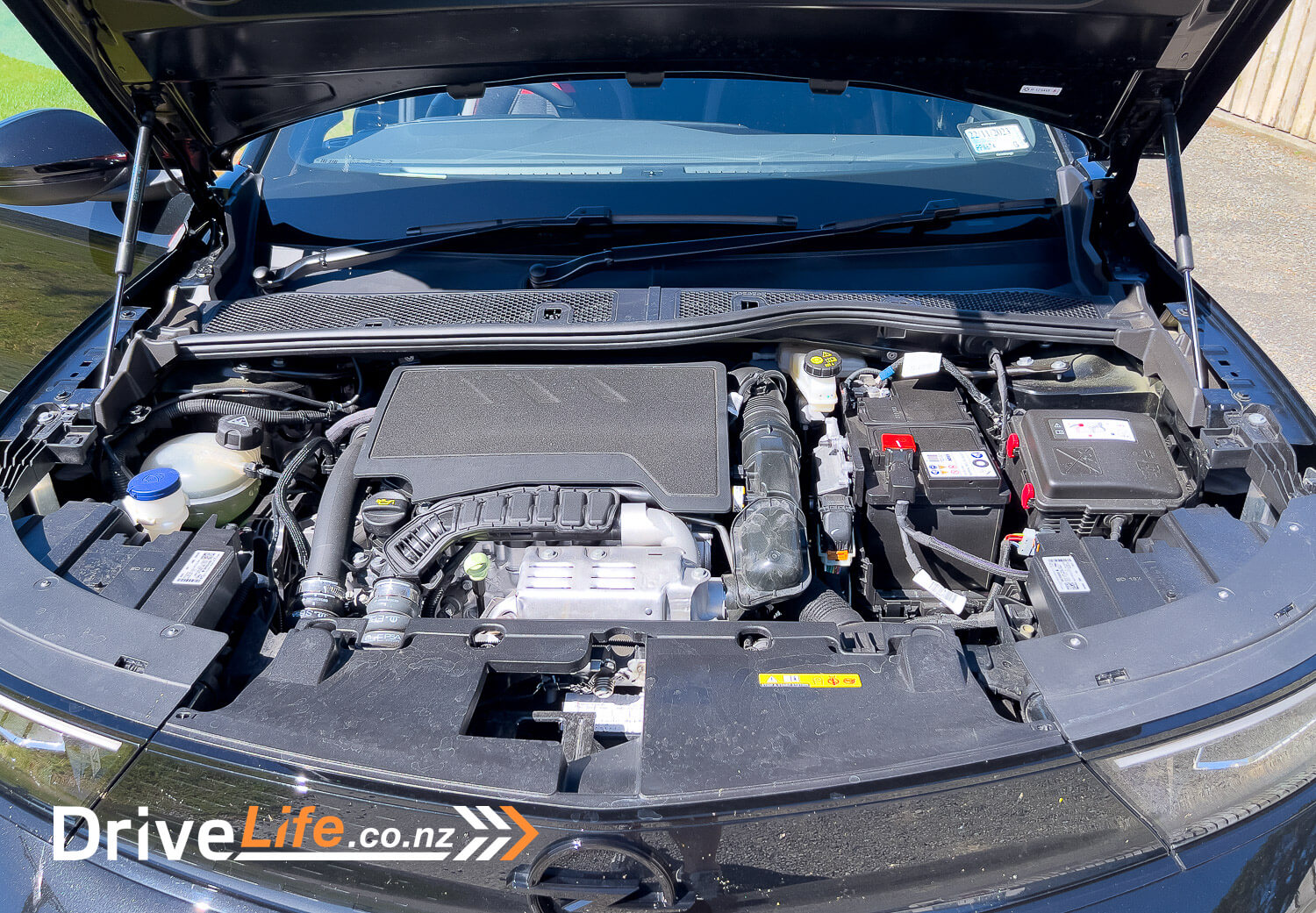
Reading the spec sheet, the 1.2-litre, 3-cylinder, 96kW engine did nothing to grab my attention. Boy was I wrong. This engine was faultless around town and when you get onto the open road, it’s also great. It did appear to have a narrow power band but the 8-speed gearbox did a near-perfect job keeping it in the range and they worked seamlessly together. With 96kW, you are not expecting bucket loads of power, but not once did I find myself thinking I needed more. The engine was very torquey when in the band, gear shifts were silky smooth and if you wanted to play yourself, flappy paddles on the steering wheel were simple to use and well positioned.
Could this be another error in the documentation? Because that engine is seriously good for something so small.
The Mokka has three drive modes, accessible via another small switch to the left of the drive selector. I tried them all, and honestly struggled to tell the difference. My daily driver is night and day when you change mode, but this, nothing. The handling stays the same, and the engine is just great no matter the mode.
Upon arriving at our destination the tank was nearing empty, and here is where a really surprising and really nice feature sprung up. All of a sudden the left touchscreen went into satNav mode and told me where all the nearest petrol stations were and how long to get there. Unnecessary, really helpful, but something that made me smile and was a nice touch.
Approx 800km later it was time to hand it over to Alistair. Despite a lot of features I didn’t gel with and not being the targeted demographic, it was mixed feelings seeing it go.
During my week-long test I managed 8.1l/100km around town and 6.3l/100km on the open road, giving a combined figure of 7.2l/100km. This is a fair bit higher than Opel’s claimed combined figure of 5.7l/100km.
Alistair’s Point of View
I was somewhat perplexed when I heard that Opel had announced it was going to launch in New Zealand. My internal monologue started with all the questions, including “how do they plan on making this successful?”
A casual observer might think well of Opel’s pitch, arriving in New Zealand with a line-up of EV’s available. But personally, I think it’s a confusing move. Opel has little of a legacy in New Zealand, having last been sold in 1994. Even then, it barely stuck around for 5 years.
One could even make the case that not even Opel knows what it is. It’s a sister of Vauxhall, owned by GM but now by Stellantis group. Opel has essentially been selling badge-engineered vehicles under different parents for the past decade.
The Mokka is no different. It’s essentially a reskinned Peugeot 2008. But modern Peugeots are good, no?
Well, yes. From new, the Peugeot line-up is actually fairly solid, and their styling is absolutely on point. The new 508 Wagon is a stunning thing to behold.
This Opel Mokka, on the other hand, is a harder sell. Sure, the SRi might have some lashings of red on it, but take that away, and you’re left with a relatively ordinary-looking small SUV.
The interior is the same story. The Peugeot interior has a funky design, with 3D-effect instrument clusters and cool retro-styled switchgear. The Mokka has, well, screens. Two of them, along with a boatload of faux carbon fibre, which in my view, belongs in a dumpster (I despise the stuff).
The screen for the driver’s instruments is good – clean, simple and sharp. The infotainment needs work. It’s the same stuff in a Peugeot and their system is not pleasant to use. Basically, there’s no home screen, instead it jumps from one application to the next. On the subject of tech, the ignition starter button requires a prolonged hold to do anything. The keyless entry seemingly had a mind of its own, to the point where I could have the key in hand and it still wouldn’t respond.
So, does it drive any better?
Because the Mokka is mostly Peugeot underneath, it does get the 1.2-litre 3-cylinder engine, which is a surprisingly fruity unit. It’s got good torque delivery and its 8-speed gearbox is smooth and well-managed. The ride quality is on par, and the steering and handling is set up to be fairly darty. Usual city-car stuff.
I am also quite impressed with Mokka’s levels of standard equipment. Short of this though, there’s really not a huge amount to write home about.
It sounds like I’m being tough on the wee Mokka. On balance, it’s not a bad car at all, and it’s actually quite good at a few things. Otherwise, it’s just too middle of the road to really give it a strong recommendation.
This brings us onto the price. At $44,990, it’s the same price as the Peugeot 2008 Allure. Sure, you can argue the Mokka has an eight-speed gearbox relative to the Peugeot’s six-speed, and the Mokka gets a small clean car rebate, and so on. But it needs to be cheaper.
Maybe I’ll warm to Opel when I get a longer time behind the wheel, but for now, I’m not sure the Mokka stands out enough to give Opel the fighting chance it needs.
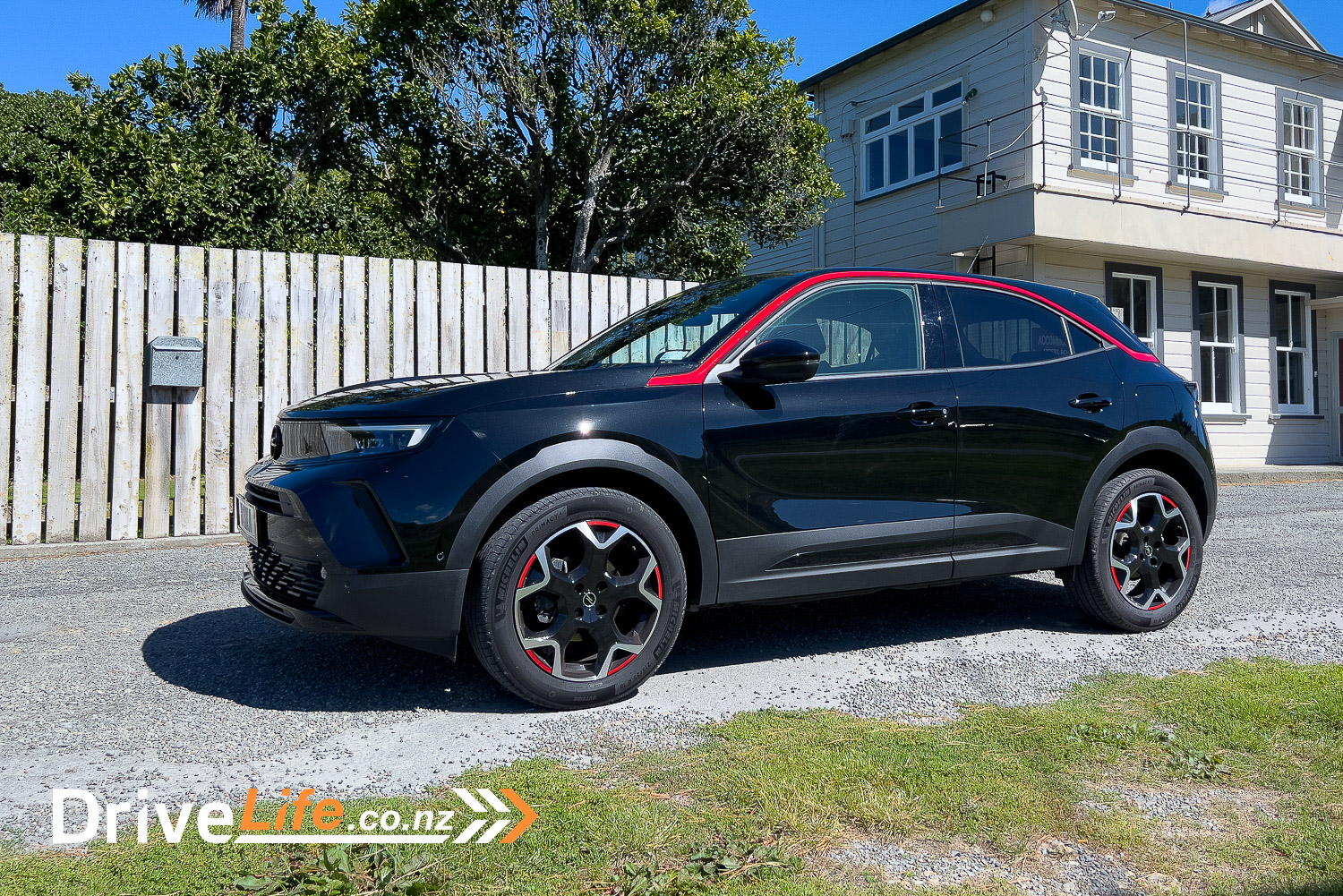
2023 Opel Mokka SRi – Specifications
| Vehicle Type | SUV |
| Starting Price | $44,990 |
| Price as Tested | $45,540 |
| Engine | 1.2-litre, 3-cylinder Turbo Petrol |
| Power, Torque kW/Nm | 96kW @ 5500rpm 230Nm @ 1750rpm |
| Transmission | 8-speed Automatic |
| Spare Wheel | No |
| Kerb Weight, Kg | 1,220Kg |
| Length x Width x Height mm | 4151 x 1791 x 1531 |
| Boot Space / Cargo Capacity, Litres (seats up/seats down) | 350 / 1,105 |
| Fuel tank capacity, litres | 44 |
| Fuel Economy, L/100km | Advertised Spec – Combined – 5.7 Real-World Test – Combined – 7.2 Low Usage: 0-6 / Medium Usage 6-12 / High Usage 12+ |
| Towing Capacity Kg, unbraked/braked | 640/1,200 |
| Turning circle metres | 11.08 Small: 6-10m / Medium 10-12m / Large 12m+ |
| Warranty | 5-year/100,000 km OPEL Vehicle Warranty 5-year Roadside Assistance |
| Safety information | ANCAP Rating – 4 stars Rightcar.govt.nz – 4 Stars |
Have you enjoyed this review? Be sure to join our monthly email newsletter list so you don’t miss a single car review!


